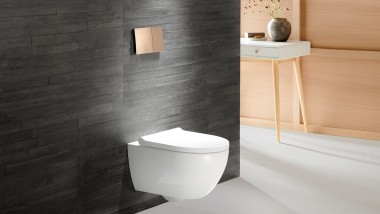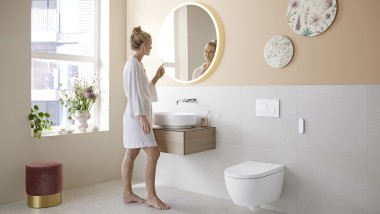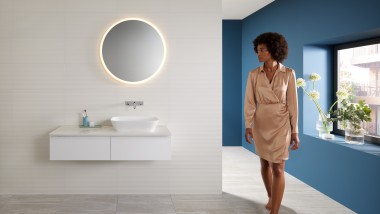Adding accents to your bathroom with wood
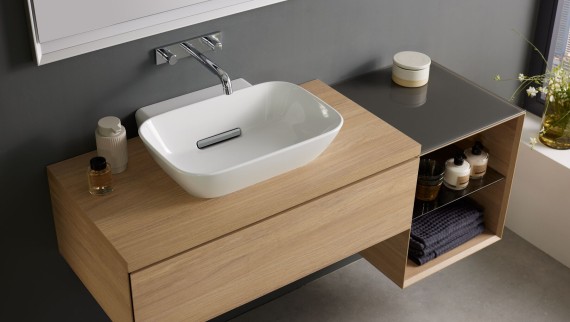
Wood is a tried-and-tested building material. Whether in buildings, on ships or on windows, it is normal for wood to come in contact with water. It’s a mystery why wood in the bathroom was frowned upon for so long. A widespread belief is that it rapidly leads to mould.
Wood has now become a common feature in the kitchen, at least. Slowly but surely, a paradigm shift is also occurring in the bathroom. Wood is used for floors, wall panels and furniture, and can play an important role in the bathroom.
At the washplace, lay-on washbasins are found increasingly on units made from beautiful solid wood. Even wood bathtubs and washbasins are now available. Combinations of wooden vanity units with ceramic washbasins are also popular.


Which wood types are particularly suited to bathroom furniture?
Various wood types are suitable for use in the bathroom. It is important that the wood surface is sealed so that moisture cannot penetrate. The best option is to consult with your dealer before purchase.
- Oak: Oak is a robust wood with water-resistant qualities. It is also well known for its durability and can cope well with moisture if it is sealed correctly.
- Larch: Due to its natural resin content, larch wood is particularly durable against moisture and putrefaction. This makes it the ideal choice for bathroom furniture.
- Robinia: Robinia is an extremely dense, hard wood, which means it is virtually indestructible in moist environments such as the bathroom.
- Douglas fir: The high strength and natural wood grains make Douglas fir a robust and aesthetically appealing choice for furniture in moist environments.
- Cedar: Cedar is moisture-resistant thanks to its natural oil and resin content. Another advantage is that it has a pleasant scent and contains natural protection against insects.
- Acacia: Acacia wood is robust and resistant to moisture. Its natural beauty and wood grains result in attractive pieces of furniture in the bathroom.
- Bamboo: Although technically a type of grass and not wood, bamboo is a good choice due to its moisture resistance. It is also hard and durable, not to mention environmentally friendly as a fast-growing material.
- Cherry: While cherry wood is not as dense as other wood types, it can also be protected well against moisture with the right sealing. It impresses thanks to its attractive natural colour and wood grains.
- Plywood: A lot of bathroom furniture is not made of solid wood but of plywood with melamine coating – in other words it has a wood design. As plywood consists of thin wood layers that are glued together, it is not as susceptible to deformation caused by moisture. Moreover, it is also particularly stable thanks to its layered structure.
Why is wooden bathroom furniture so popular?
Wood is a popular material in the bathroom as it has a positive effect on the atmosphere. Wood is a living thing, which means it can absorb moisture and also emit it. This has a positive, healthy impact on the climate in the room.
Less well known, but just as important: some wood types also have antibacterial properties thanks to their high acidity. This is particularly advantageous in the bathroom – a place where hygiene is taken very seriously.
Tips: Things to look out for when using wooden bathroom furniture
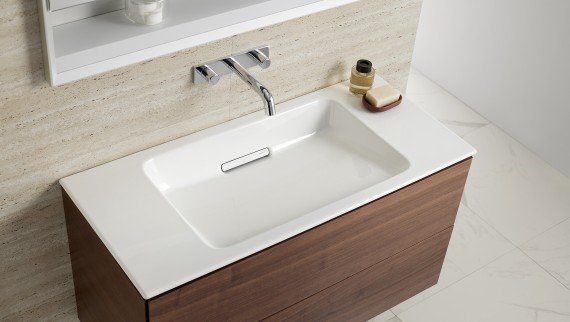
Wood in the bathroom is a good thing. But watch out – certain aspects have to be taken into account when choosing the wood for bathroom furniture. This is because a lot of moisture is created in the bathroom, particularly when taking a shower or bath.
Select the right wood for direct contact with water
Many wood types are ideal. However, caution should be exercised with some – particularly if they come in direct contact with water.
- Pine: Susceptible to blue-stain fungi in the event of prolonged exposure to moisture.
- Walnut: Can become discoloured due to water absorption.
- Maple: A very hard wood, but susceptible to stains when cleaning agents are used.
- Redwood (such as merbau or jatoba): Quickly develops unsightly shadows when coming in contact with moisture.
Correct handling and care for bathroom furniture made of solid wood
Once the right wood has been chosen for the bathroom furniture, floor or wall panels, the next issue is looking after it. Here are some tips:
- Ideally, water splashes should be wiped off immediately so the water cannot penetrate the wood.
- Aggressive cleaning agents should not be used on solid wood.
- Anyone using oiled wood should apply care oil on a regular basis. This prevents the wood from swelling and ensures it remains sealed and repellent to dirt.
- Good ventilation is essential.
- Wood surfaces can usually be wiped off with a damp cloth – nothing else is needed.
- Wood protector with chemical agents against fungi and insects can be dispensed with in the bathroom if these rules of thumb are followed.
For anyone requiring even easier handling and care, furniture made of plywood with melamine coating in wood design is also a good choice. This furniture is less susceptible to moisture and is easy to clean.
Ensure back ventilation of wood cladding
Back ventilation of wood cladding means leaving an air gap between the cladding and the wall. This air gap enables natural ventilation and helps to regulate moisture levels. The space between the wall and cladding is called a back-ventilation gap.
Back ventilation has the following benefits:
- Moisture regulation: Air circulates through the back-ventilation gap between the wall and wood cladding. Moisture is then automatically reduced. This is particularly important in bathrooms due to the high levels of humidity.
- Preventing mould: Thanks to ventilation, the moisture that can collect behind the cladding evaporates. This reduces the risk of mould formation.
- Thermal insulation: The back-ventilation gap also has an insulating effect, which results in improved thermal performance.
- Extension of service life: The back-ventilation gap prevents the cladding from coming in direct contact with the wall. This can extend the service life of the wood as it is better protected against potentially damaging influences.
Planning your bathroom? These questions often arise
Where can I find exclusive wooden bathroom furniture?
What impact does wooden bathroom furniture have?
Newsletter Register now
Stay up to date
Our newsletter provides fascinating insights and handy tips on how your bathroom can make your life easier.







